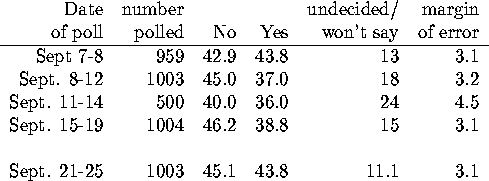
SCI199Y: October 10, 1995
Required for two weeks from now
Some technicalities on polls
Allocating the undecideds
In the poll reported on September 30 in the Globe and Mail (front page), the results were given as 53.2% for no, and 46.8% for yes. Later in the article, the results were given as:

According to the reporter, the undecideds and won't says are grouped, and their votes are allocated in the ratio 70% to no, 30% to yes. (In fact my calculation shows that 76% was assigned to no.)
Later in the same article, a study from three weeks earlier is quoted as giving the results 49.8% for no and 50.2% for yes. The detailed breakdown was:

In this poll about 50% of the undecideds and won't says were were allocated to the no group. So a large part of the shift is due to a change in the method of allocation.
The margin of error
For the poll quoted above (the first one), it is also stated in the article that 1,006 people were polled, and that the poll has a margin of error of 3.1%, 19 times out of 20. The way to compute the margin of error is simple:

In this poll, that is

. The theory behind this is sketched on the next page.
The polling trend
In an article on September 26 in the Globe and Mail, headlined "Polls show trend", the following results were given:

(I've added the poll reported on Sept. 30 myself.) Does it look like a trend to you?
In the news this week...
Monty Hall again... This rather elegant solution was posted on the internet. I think it's okay...
There are two strategies:In case 1, the probability of winning is 1/3. In case 2, the probability of losing is 1/3, because you will lose only if you had picked the winning door first.
- You stay with your initial pick all the time.
- You switch doors every time.
Theory behind the margin of error

, and the sample size by

.

. We don't know

, but use the sample estimate again.

catches the true proportion 95% of the time (19 times out of 20). The factor 2, the 95% and the

comes from the 'bell curve', or normal distribution, used here as an approximation to the binomial distribution.
This document was generated using the LaTeX2HTML translator Version 0.6.4 (Tues Aug 30 1994) Copyright © 1993, 1994, Nikos Drakos, Computer Based Learning Unit, University of Leeds.
The command line arguments were:
latex2html -split 0 lec5.tex.
The translation was initiated by Marie K. Snell on Thu Nov 16 14:52:59 CST 1995